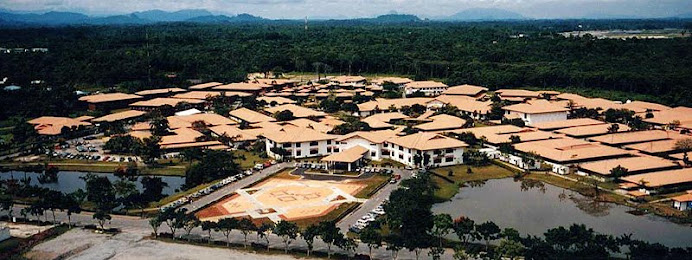So many of us in the West are captivated by these cute and intelligent creatures, at the same time subhuman and superhuman. Scores of American and European NGOs are committed to preventing orangutan extinction and protecting their jungle habitat. The orangutan exhibit at zoos is always among the most popular, regardless of the captive apes' typical inactivity and depressed demeanor. Yet despite the love affair on the part of us Westerners, or orang putih ("white men"), the people who actually share space with orangutans, or orang hutan ("forest men"), often regard them as pests. No different from ranchers protecting their livestock, villagers are liable to kill menacing orangutans who eat from their fruit trees, threatening their livelihoods.
Thirty minutes from the campus is a very neat place to see the orangutan in safe and nearly natural conditions. This past Sunday I visited the Semenggoh Wildlife Rehabilitation Centre with Seon, Min Sun, and our friend Gary who works for UNIMAS.
Feeeding time occurs twice a day when the park staff leave out fruit on a wooden platform separated from a tiered viewing area for park visitors. We arrived an hour before the three o'clock feeding, so I enthusiastically suggested we take a walk down one of the park's many trails.

 Merely stepping foot into a real tropical rainforest put a big smile on my face, but overall the hike may have been a bad idea. Wouldn't you just know it that the map at the trailhead wasn't exactly up to date? We ended up walking twenty minutes in and twenty minutes straight back, rather than the planned route which would have brought us nicely to the orangutan viewing area with time to spare. We ended up rushing back and making it just in time to see the orangutans' dramatic arrivals from all directions.
Merely stepping foot into a real tropical rainforest put a big smile on my face, but overall the hike may have been a bad idea. Wouldn't you just know it that the map at the trailhead wasn't exactly up to date? We ended up walking twenty minutes in and twenty minutes straight back, rather than the planned route which would have brought us nicely to the orangutan viewing area with time to spare. We ended up rushing back and making it just in time to see the orangutans' dramatic arrivals from all directions.Concern about missing feeding time wasn't the only reason we rushed. Halfway back to the trailhead, with Seon and I lagging behind teaching each other patriotic songs from our respective countries, Min Sun and Gary stopped. Min Sun was looking down at her leg and Gary, slightly panicked, told us to hurry past them and stop up ahead. We soon found out that Min Sun had two leeches sucking away at the back of her left leg. Gary removed them, and then we all hustled the heck back to the main road.

We surveyed the damage once we'd finally reached safe ground. Unfortunately, Min Sun, who is very easily frightened, by far had it the worst. She needed five leeches removed from her feet and legs, and she wasn't the least bit happy about it. Seon had two leeches. Zero actually tasted my blood, but four were on my shoes, and one was under my foot inside my shoe. How it got there I'll never understand. I wouldn't have even thought to check inside my shoe if it weren't for Gary. Amazingly, Gary was wearing shorts and sandals, yet not one leech touched him. The reason, he says, is because his job has taken him into the jungle many times and he's learned how to walk in a manner to avoid leeches.
Having regained our composure, we found the trail to the orangutan viewing area. In no more than two minutes I was already standing next to a tree in which an orangutan clung thirty feet above. As it turned out, our arrival to the viewing area coincided with the arrival of the last of the orangutans who cared to show up for feeding time that afternoon. I can't describe my excitement as I walked along a path through the jungle with orangutans swinging through the trees above my head. Our destinations were the same, but our modes of getting there were comically different.





 At one point two of them were giving chase to a third who had snatched the lone coconut set out by the park staff. In the end, the others gave up and the early ape got the fruit.
At one point two of them were giving chase to a third who had snatched the lone coconut set out by the park staff. In the end, the others gave up and the early ape got the fruit.
 --------------
--------------Below is a map from the United Nations Environment Program website showing the past, present, and projected extent of deforestation in Borneo. Saving the rainforests of Borneo is not primarily a matter of pressuring the government to protect more land or collecting money to purchase more acres. Today, nearly every square mile of remaining primary forest is already at least officially protected, either as a national park, sanctuary, or something else. The logging that is still taking place is almost all illegal and simply hard to prevent.


